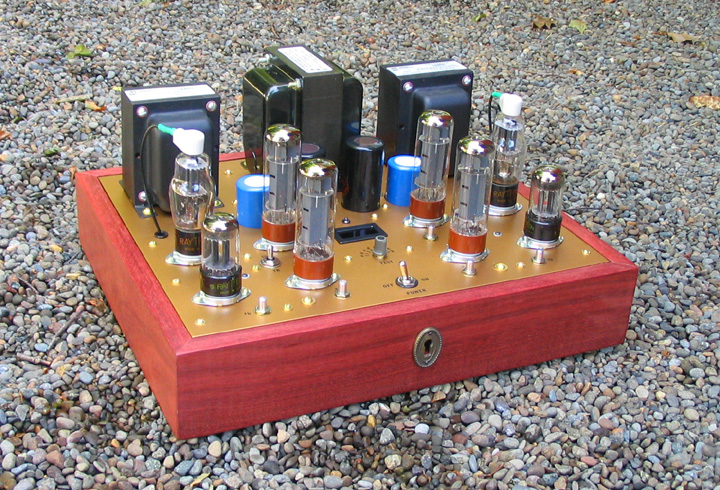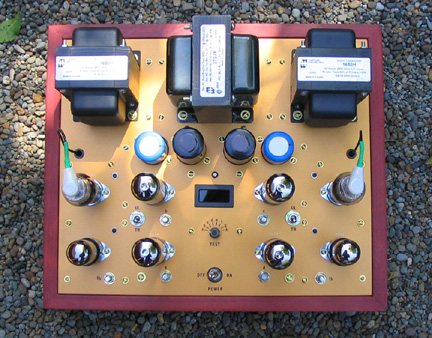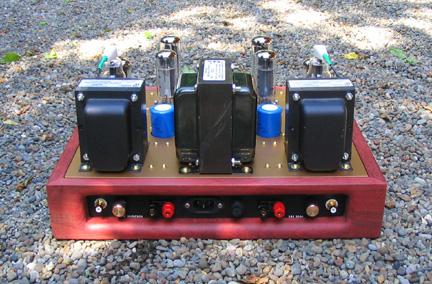
Copyright (c) 2008, Robert B. Richards, all rights reserved internationally.

Why tubes?
Most people know that tube amps "clip" (overdrive) in a more gradual way, that is less audible, compared to the vast majority of transistor amplifier circuits. Virtually all transistor circuits clip (overdrive) with very abrupt, sharp corners, which is significantly more audible.
When run at a lower levels where clipping never occurs, acording to my studies, the best tube sound appears to happen when there's significantly less negative feedback, and the circuit topology is either single ended or slightly un-balanced push-pull. It's all about the harmonic distortion spectrum shape. The ideal condition is where the second harmonic distortion product is higher than the 3rd harmonic distortion product, and after that, the higher order harmonic distortion products roll off fairly quickly.
Feedback causes the distortion products to extend further out from the fundamental before they die off, which makes the distortion more audible and less musically related to whatever the fundemental frequency is (the note being played on whatever instrument). Although these distortion products are extremely low in amplitude in a well designed not-overdriven circuit, its thought that they add up in the compexity of real world music, thereby imprinting a slight coloration to the sound. Since the 2nd harmonic is the same as the fundemental frequency, but one octave higher, it has the effect of enhancing any sound. The higher order harmonic distortion products are "hit and miss" as to whether they are pleasantly musically related to the fundemental and first few distortion products.
A precisely balanced circuit will generate only odd harmonics, which don't have as good a sound, as the more natural sounding "whole" distortion generation (roughly equal amounts of even and odd harmonic distortion products, with the second harmonic dominating). Distortions that could be called "whole" or natural, are less damaging to the sense of reality than distortions that create the less natural distortion spectrum shape.
This amplifier is an example of both the single ended concept in the front end, and a strategically slightly unbalanced differential amp driving a push-pull output stage. The only feedback is ultra-linear local feedback in the push-pull output stage (unless Triode Mode is selected), and a variable partial loop feedback (zero to roughly 15dB) that goes from the output to the diff amp that drives the push-pull output stage. The front end stage is outside of any feedback loop at all times, so its arguably perfect harmonic distortion spectrum shape is left untainted. The slightly unbalanced (about 1dB) drive to the push-pull output section creates a distortion spectrum shape that is very similar to that of the front end single ended triode when there's no feedback. When the loop feedback is turned up thereby reducing amplifier output impedance (generally desireable), higher order (less desireable) harmonics become more significant, in the output section only, but the second harmonic distortion product still dominates. That may be about as good as it gets.
I must apologise for the many pictures and calulations that applied to the first version of this amp, which are no longer current (such as above). The input stage tube with the grid cap looked so cool, but picked up a tiny bit of radiated 60HZ hum from the power tranny, since the grid circuit is high impedance, so I replaed that tube with a 6SN7 in the final version of this amp.
After researching, designing and building several guitar amps, and collaborating with Matt Kamna (one of the great "Tube Guru's" of our time), I felt I had really gotten inside what brings out the best in a tube, and in amplification in general. At that point, I felt compelled to design and build a truly excellent tube Hi-Fi amp. I looked at and anayzed dozens of different tube amp schematics that I found on the web. I played with many different topologies, crunching numbers, collaborating with Matt and learning the problems with each design as I went along. After sucking in all the info I could find, I asked my brain to come up with the ultimate version of something like a Dynaco Stereo 70 amp, that would be practical, affordable and have the magic of tubes in its sound signature. Here's what I came up with:

Stereo. No fully global feedback (so better phase margin).
Built in digital meter for checking and setting output tube bias (quiescent current).
Variable limited-route feedback 0-15dB.

30 watts rms per channel Ultralinear mode/ 16 watts rms in Triode mode (into 8 ohms).
Anything less than 30 watts puts pretty big limitations on what speakers you'll want to use, especially if you like juicy low bass.

To skip to the circuit diagram and calculations, click here.
To skip to test results of the virtually finished amp , click here.
For more photos and much discussion on the circuit development and building process (my original webpage) click here.
There's an intereesting very in depth discussion of how tubes compare with transistors - see excerpts below.
IEEE Spectrum August 1998 Volume 35 Number 8 By Eric Barbour, on the web at
http://milbert.com/articles/cool_sound_of_tubes , or just click here to get there.
It's one of the more in depth articles I've seen on this subject.
Here are two excerpts from it:
In Atwood's opinion, "Some of the differences in the audio qualities between tubes and transistors have to do with the inherent physical properties of the devices and with the circuit topologies and components used with each type of device. There is no way around it: linear [triode] vacuum tubes have lower overall distortion than bipolar transistors or FETs, and the distortion products are primarily lower-order...the clipping characteristic of tubes is actually not much softer than transistors, but feedback tends to 'square-up' the clipping. Thus, the heavy feedback in most solid-state designs gives them worse overload performance. "A low- or no-feedback design can be driven harder without audible distortion," Atwood continued. "High feedback also can lead to transient intermodulation distortion (TIM), caused by clipping or slew-rate limiting within the feedback loop."
Speaking about solid-state designs, Whitlock asserted that they "...depend on huge amounts of negative feedback to 'fix everything', including crossover distortion. Op amps commonly have open-loop THD in the 20 percent to 70 percent range. Stabilization generally requires open-loop gain to fall at 6 dB per octave. This means that, for ultrasonic input signals, the op amp has little gain margin to fix its own distortion. The ultrasonic signals, along with distortion products, are fed to the next stage for further distortion and intermodulation. This intermodulation creates audible, but non-harmonically related, artifacts which contaminate the noise floor and mask many subtle features of the music."
Here's a great piece I found on the psycho-acoustic effects of harmonics:
SIGNIFICANCE OF MUSICAL HARMONICS
Having divided amplifiers into three groups of distortion characteristics,the next step is to determine how the harmonics relate to hearing. There is a close parallel here between electronic distortion and musical tone coloration that is the real key to why tubes and transistors sound different. Perhaps the most knowledgeable authorities in this area are the craftsmen who build organs and musical instruments [8] [9]. Through many years of careful experimentation these artisans have determined how various harmonics relate to the coloration of an instrument's tonal quality. The primary color characteristic of an instrument is determined by the strength of the first few harmonics. Each of the lower harmonics produces its own characteristic effect when it is dominant or it can modify the effect of another dominant harmonic if it is prominent. In the simplest classification, the lower harmonics are divided into two tonal groups. The odd harmonics (third and fifth) produce a "stopped" or "covered" sound. The even harmonics (second, fourth, and sixth) produce "choral" or "singing"sounds. The second and third harmonics are the most important from the viewpoint of the electronic distortion graphs in the previous section. Musically the second is an octave above the fundamental and is almost inaudible; yet it adds body to the sound, making it fuller. The third is termed a quint or musical twelfth. It produces a sound many musicians refer to as"blanketed." Instead of making the tone fuller, a strong third actually makes the tone softer. Adding a fifth to a strong third gives the sound a metallic quality that gets annoying in character as its amplitude increases. A strong second with a strong third tends to open the "covered"effect. Adding the fourth and the fifth to this changes the sound to an"open horn" like character. The higher harmonics, above the seventh, give the tone "edge" or "bite."Provided the edge is balanced to the basic musical tone, it tends to reinforce the fundamental, giving the sound a sharp attack quality. Many of the edge harmonics are musically unrelated pitches such as the seventh,ninth, and eleventh. Therefore. too much edge can produce a raspy dissonant quality. Since the ear seems very sensitive to the edge harmonics,controlling their amplitude is of paramount importance. The previously mentioned study of the trumpet tone [6] shows that the edge effect is directly related to the loudness of the tone. Playing the same trumpet note loud or soft makes little difference in the amplitude of the fundamental and the lower harmonics. However. harmonics above the sixth increase and decrease in amplitude in a1most direct proportion to the loudness. This edge balance is a critically important loudness signal for the human ear.
THE AUTHOR Russell 0. Hamm received his engineering training at the University of NewHampshire. He worked for Vidcom Electronics and later the Fine Recording division of that Company, designing and supervising the installation of their extensive sixteen-track recording facilities While with Fine Recordings, Mr. Hamm did a great deal of experimentation in stereophonic and quadraphonic sound for records and motion pictures which, in conjunction with Peter Scheiber, formed the basis for the development of the present matrix-quad record. (there was more)
Earlier on he had stated that he felt that it was the tube amplifiers higher output impedance that was responsible for most (90%) of the sound difference between tubes and transistors. A transistor amp typically has around 50-100 milliohms output Z (due to the very high amounts of negative feedback) while the tube amps were often over an entire ohm of output Z, thereby allowing the speaker to resonate a bit (or resonate at a substantially lower frequency). This made sense to me, so I stuck 1 ohm R's on the outputs of some of my Hafler DH120 trasistor poweramps. I lost a few watts but who cares. I'm not sure I could hear any difference. Adding an ohm of output Z will slightly shift the way a passive crossover network in the speaker system will work (assuming your speaker has a passive crossover in it). If the amplifier output Z is several ohms (when feedback is close to zero), it will shift the rolloff frequencies of the passive crossover network significantly, and may or may not leave the speaker system more "calibrated". When people claim that no feedback sounds better, I have to wonder if they took this issue into account.
More recently he stated that perhaps a bigger reason why tubes sound better is because of the speaker simultaneously acting as a microphone, picking up the acoustic reflections from the listening room, and sending that electrical signal back into the output stage of the amplifier, where some of it can get into the negative feedback loop of the amplifier that is driving the speaker, only to re-emerge mixed with the source signal, creating what might be a significantly attenuated frequency selective "chorus/reverb" effect. Since tube amps usually have higher output impedances (due to much less NFB), it is imaginable that this signal from the speaker acting as a microphone could get past the relatively low (but not zero) output stage impedance, and into the feedback circuit.
Although these issues could be a significant part of the tube amp sound in many "golden era" tube amps in general (late 1950's and there abouts), I know of several people who claim to be hard-core tube amp designers who argue that no feedback sounds best. A no feedback tube amp would have an output impedance of several ohms, which would allow the woofer to have a bit of resonance often around 60HZ, and arguably un-calibrate any passive crossover network that is in the speaker system it drives. It would also allow more of the CMF (counter electro-motive force) voltage generated by the speaker simultaneously acting as a microphone, to get into the negative feedback loop circuit, possibly creating a slight chorus/reverb effect, which might sound like an improvement, although is a step away from "fidelity".
Many of these same people don't believe in having any tone controls in their system. Without tone controls, they may prefer the sound of a woofer that has that resonance that is usually around 50-60HZ when amplifier damping is minimal, in order to have any warmth in the system (?). Many other contemporary tube amp designers say that about 12dB of NFB is ideal. This would reduce the output impedance, which would to some extent "tame" the effects of the speaker driver resonance(s), without significant effects from very high negative feedback (not much extending of the harmonic distortion products out from the fundamental). For reference sake, The Dynaco ST70 has about 26dB of NFB, which may have been typical in the so called "golden era" (late 1950's/ early 1960's). No feedback causes the highest output impedance (Approx. 8 ohms in my Musicbox amp in "ultralinear" mode with NFB set to zero), and minumal spread of harmonic distortion products in frequency.
It would be interesting to use a tube amp with no feedback and best possible harmonic distortion spectrum shape (like my Musicbox amp above), and instead of releying on the speaker to act as both an output and input device simultaneously, to have a separate speaker acting as a mic (you could even use a mic acting as a mic), sending a signal directly into a mixer input on the power amp, so you could vary the amount of this effect. Then you could over do it so its effects would be very consciously audible, and decide if you like it. It would of coarse be different in each listening room. The phase of the mixed in signal might sound better one way than the other (complex comb-filter type cancellations will be at different frequencies).
Everytime you change anything in a low feedback system, it changes many other things. Interactivity is rampant, so it's hard to research many of these things without drawing conclusions based on assumptions and incomplete data. There are usually variables that aren't accounted for.
Click here to go to Front Page of Website.
Click here to go to Audio Projects Table of Contents.
![]()